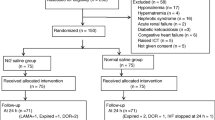Abstract
Objective
To compare the safety and efficacy of isotonic versus hypotonic maintenance fluid in children.
Design
Randomized controlled trial.
Setting
Tertiary-level teaching hospital.
Participants
60 children (age 0.5 to 12 years) who were admitted and anticipated to receive intravenous fluid for the next 48 hours.
Intervention
Hypotonic fluid (Standard maintenance volume as 0.18% NaCl in 5% dextrose) or Isotonic fluid (60% Standard maintenance volume as 0.9% NaCl solution in 5% dextrose).
Outcome measures
Primary: Incidence of hyponatremia. Secondary: Serum sodium, serum osmolality, blood sugar, blood urea, serum creatinine, serum potassium, serum chloride, pH, urine output, change in weight, morbidity and death.
Results
At 24 hours, hyponatremia was noted in 7 (24%) patients in the isotonic and 16 (55%) in hypotonic group (P=0.031). At 48 hours, hyponatremia was noted in 4 (14%) and 13 (45%) patients in isotonic and hypotonic group, respectively (P=0.02). There was significant change in sodium levels in both isotonic (P=0.036) and hypotonic (P<0.001) intervention groups. The peak fall in mean serum sodium level was noted at 24 hours (−6.5, 95%CI: −3.5, −9.6 mEq/L; P<0.001) in hypotonic group. In isotonic group, there was significant increase between 24 and 48 hours (4.3, 95% CI: 0.1, 8.4 mEq/L; P=0.04).
Conclusions
Reduced volume isotonic fluid results in fewer episodes of hyponatremia than hypotonic fluid in sick children during the first 48 hours of intravenous fluid therapy.
Similar content being viewed by others
References
Holliday MA, Segar ME. Maintenance need for water in parenteral fluid therapy. Pediatrics. 1957;19:823–32.
Anderson RJ. Hospital associated hyponatremia. Kidney lnt. 1986;29:1237–47.
Arieff AI, Ayus JC, Fraser CL, Hyponatraemia and death or permanent brain damage in healthy children. BMJ. 1992;304:1218–22.
Halberthal M, Halperin ML, Bohn D. Acute hyponatremia in children admitted in hospital. BMJ. 2001;322:780–2.
Holliday MA, Friedman A, Segar ME, Chesney R, Finberg L. Acute hospital induced hyponatremia in children: A physiological approach. J Pediatr. 2004;145:584–7.
Montañana PA, Modesto i Alapont V, Ocón AP, López PO, López Prats JL, et al. The use of isotonic fluid as maintenance therapy prevents iatrogenic hyponatremia in pediatrics: A randomized, controlled open study. Pediatr Crit Care Med. 2008;9:658–9.
Briassoulis G, Venkataraman S, Thompson AE. Energy expenditure in critically ill children. Pediatr Crit Care Med. 2000;28:1166–72.
Choong K, Bohn D. Maintenance parenteral fluids in the critically ill child. J Pediatr (Rio J). 2007; 83:S3–10.
Duke T, Mokela D, Frank D, Michael A, Paulo T, Mgone J, et al. Management of meningitis in children with oral fluid restriction or intravenous fluid at maintenance volumes: a randomized trial. Ann Trop Pediatr. 2002;22:145–57.
Hoorn EJ, Geary D, Robb M, Halperin ML, Bohn D. Acute hyponatremia related to intravenous fluid administration in hospitalized children: An observational study. Pediatrics. 2004;113:1279–84.
Brazel P, McPhee IP. Inappropriate secretion of antidiuretic hormone in postoperative scoliosis patients: The role of fluid management. Spine. 1996;21:727.
Neville K, Verge C, Rosenberg A, O’Meara M, Walker J. Isotonic is better than hypotonic saline for intravenous rehydration of children with gastroenteritis: A prospective randomized study. Arch Dis Child. 2006;91:226–32.
Kannan L, Lodha R, Vivekanandhan S, Bagga A, Kabra SK, Kabra M. Intravenous fluid regimen and hyponatraemia among children: A randomized controlled trial. Pediatr Nephrol. 2010;25:2303–9.
Yung M, Keeley S. Randomised controlled trial of intravenous maintenance fluids. J Paediatr Child Health. 2009;45:9–14.
Choong K, Arora S, Cheng J, Farrokhyar F, Reddy D, Thabane L, et al. Hypotonic versus isotonic maintenance fluids after surgery in children: A randomized controlled trial. Pediatrics. 2011;128:857–66.
Saba TG, Fairbairn J, Houghton F, Laforte D, Foster BJ. A randomized controlled trial of isotonic versus hypotonic maintenance intravenous fluids in hospitalized children. BMC Pediatr. 2011;11:82.
Author information
Authors and Affiliations
Corresponding author
Rights and permissions
About this article
Cite this article
Shamim, A., Afzal, K. & Manazir Ali, S. Safety and efficacy of isotonic (0.9%) vs. hypotonic (0.18%) saline as maintenance intravenous fluids in children: A randomized controlled trial . Indian Pediatr 51, 969–974 (2014). https://doi.org/10.1007/s13312-014-0542-5
Received:
Revised:
Accepted:
Published:
Issue Date:
DOI: https://doi.org/10.1007/s13312-014-0542-5




